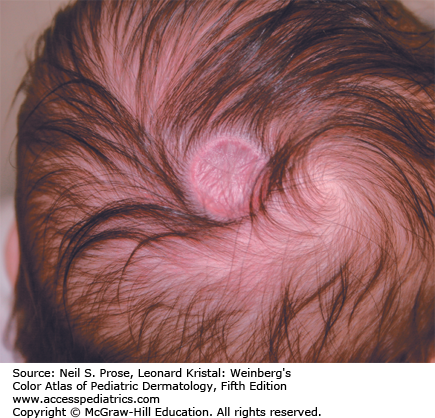Dermatology Question of the Week: Pediatric Problems

A 2-week-old male infant presents with a congenital lesion on the scalp pictured below.

The parents report no bleeding from the lesion and no significant trauma at birth. The infant is otherwise healthy, with normal developmental milestones.
What is the next best step in management?
A. Observation and routine follow-up
B. Surgical excision with primary closure
C. MRI of the brain
D. Skin biopsy of the lesion
E. Topical antibiotics and wound care
Rationale: Aplasia cutis congenita (ACC) presents as an erosion, ulcer, scar, or atrophic macule on the skin due to the lack of development of skin in this area. It commonly involves the scalp but can be seen in other areas. ACC is typically a benign condition, but the presence of the hair collar sign significantly raises concern for underlying neural tube defects.
Correct answer: C. MRI of the brain
The "hair collar sign" is a ring of darker and coarser hypertrichosis surrounding an area of aplasia cutis. This sign is associated with an increased risk of underlying neural tube defects or encephalocele. An MRI is critical to evaluate for underlying abnormalities, particularly in midline or vertex scalp lesions. Identifying potential intracranial involvement determines the need for further intervention or surgical planning.
Incorrect answers:
A. Observation and routine follow-up
While small, uncomplicated lesions of ACC can be managed conservatively, the presence of the hair collar sign warrants further investigation for underlying anomalies. Observation alone risks missing potentially serious underlying defects.
B. Surgical excision with primary closure
Immediate surgical intervention is not appropriate without first excluding underlying defects. Surgery may pose a significant risk if underlying structures are involved; therefore, imaging is required before proceeding.
D. Skin biopsy of the lesion
A skin biopsy is unnecessary for the diagnosis of aplasia cutis and risks unnecessary trauma, infection, or damage to underlying structures.
E. Topical antibiotics and wound care
While wound care may be appropriate for the prevention of infection, in this case, it is not the best first step in the management of this patient.
Additional reading at Fitzpatrick's Dermatology Chapter 103: Neonatal Dermatology and
Weinberg's Color Atlas of Pediatric Dermatology Section 30: Miscellaneous Anomalies

Create a Free MyAccess Profile
AccessMedicine Network is the place to keep up on new releases for the Access products, get short form didactic content, read up on practice impacting highlights, and watch video featuring authors of your favorite books in medicine. Create a MyAccess profile and follow our contributors to stay informed via email updates.